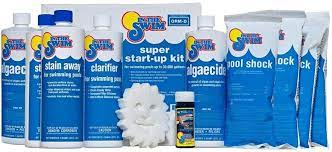Introduction to Pool Test Strips Pool test strips are essential tools for maintaining the water…

Purchasing the right pool chemical kits can help ensure that your water remains safe to swim in. Before investing in a kit, it’s important to understand what each product is used for. Learn what Algicides are, Chloramines sting, and Non-chlorine sanitizers do. You’ll also want to know how to use Mineral sanitizers, which protect chlorine from being burned off by the sun.
Chloramines sting your eyes
One of the worst side effects of chloramines is stinging your eyes. Chloramines can have a negative impact on the pH balance of your pool water. The human eye has a pH range of 7.4 to 7.6. Water with an irritable pH balance is not safe to swim in. If your eyes are inflamed by pool chemicals, you should consult a doctor.
Chloramines are produced from pee, poop, sweat, and dirt. Getting into the pool with diarrhea or vomiting will worsen the irritation. Besides, you must make frequent bathroom breaks to avoid it. Children, especially those with young bodies, should never use the pool as a restroom. You should also make sure that they change their swim diapers in the bathroom before entering the pool.
Mineral sanitizers keep chlorine from being burned off by UV rays
While UV rays can burn off chlorine, mineral sanitizers prevent them from being destroyed. They do this by breaking down contaminants by releasing ions. Typical mineral sanitizers are made of copper or silver. They disperse them into water via a feeder, floater, or skimmer. Ionizers can also be installed inline and dispense the ions. The ionizers are certified by the NSF 50 standard.
Two types of sanitizers are available: bromine and chlorine. While they are cousins, bromine has a slightly different personality. Bromine is not stable when exposed to the UV rays and will burn off if left unprotected. Mineral sanitizers can be purchased online or in store. They are a great option for sanitizing your swimming pool.
Non-chlorine sanitizers keep pH at the right level
While chlorine is the most commonly used sanitizer, non-chlorine products have a similar purpose. They keep pH levels at the correct level in the pool. Typically, you should have a pH level of 7.2 to 7.6, although it depends on the sanitizer used. Chlorine products are categorized as free chlorine, combined chlorine, or trichlor.
Chlorine is a natural sanitizer, but it can be destroyed by the sun’s ultraviolet rays. Chlorine decomposes into chloramines, a waste product that contributes to the odor of your pool. These waste products can irritate the eyes and dry out the skin. They are not healthy to breathe either.
Best pool chemical kits
The LaMotte 3368-NJ Pool Manager is a top-quality testing kit that offers numerous innovative features. This kit is easy-to-use and provides accurate readings. It uses LaMotte Visual Gradetest tablets to measure free chlorine, alkalinity, and acid demand. It also has a longer shelf-life than reagents, ensuring accurate results every time. The LaMotte 3368-NJ has a great price-to-performance ratio and a convenient polyethylene case.
A simple salt water test kit has a low error rate of around 200 ppm. A digital tester is more accurate but requires mixing of chemicals. It is better than a drop test kit, as it removes any doubt about chemical levels and salinity. A good kit should also include a chromate indicator and silver nitrate reagent, which are potentially dangerous. When using these tools, you should follow the instructions carefully to prevent accidental exposure.























